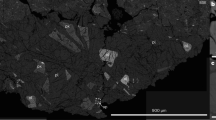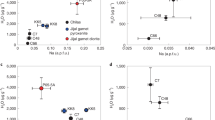Abstract
FROM October 1980 to October 1986 the dacite lava dome at Mount St Helens grew through the accumulation of more than 15 separate lobes during extrusive episodes that lasted from 1 to 24 days, except for an anomalous period of continuous growth throughout most of 19831. Over these six years, the growth rate was generally volume predictable; that is, the amount of lava added to the dome in a given eruption was roughly proportional to the time since the preceding extrusion2. These well documented eruptions were separated by repose intervals lasting from several months to more than a year2. In an attempt to identify the triggering mechanisms for these periodic eruptions, we have used hydrogen isotope analyses to determine water content and deuterium content for 18 samples of the Mount St Helens dome dacite. These isotope data, the first ever collected from an active lava dome, suggest a steady-state process of magma evolution combining crystallization-induced volatile production in the chamber with three different degassing mechanisms: closed-system volatile loss in the magma chamber, open-system volatile release during ascent and kinetically controlled degassing upon eruption at the surface. The data suggest that future dome-building eruptions may require a new influx of volatile-rich magma into the chamber.
This is a preview of subscription content, access via your institution
Access options
Subscribe to this journal
Receive 51 print issues and online access
$199.00 per year
only $3.90 per issue
Buy this article
- Purchase on Springer Link
- Instant access to full article PDF
Prices may be subject to local taxes which are calculated during checkout
Similar content being viewed by others
References
Swanson, D. A. et al. Geol. Soc. Am. Spec. Pap. 212, 1–16 (1987).
Swanson, D. A. & Holcomb, R. T. Proc. Volcan. 2, 1–24 (1989).
Cashman, K. V. & Taggart, J. E. Science 221, 1385–1387 (1983).
Anderson, S. W. & Fink, J. H. Proc. Volcan. 2, 25–46 (1989).
Barnes, I. J. Volcan. geotherm. Res. 22, 133–146 (1984).
Newman, S., Stolper, E. M. & Epstein, S. Am. Miner. 71, 1527–1541 (1986).
Taylor, B. E., Eichelberger, J. C. & Westrich, H. R. Nature 306, 541–545 (1983).
Taylor, B. E. Min. Soc. Am. Rev. Miner. 16, 185–226 (1986).
Casadevall, T. et al. Science 221, 1383–1385 (1983).
Newman, S., Epstein, S. & Stolper, E. M. J. Volcan. geotherm. Res. 35, 75–96 (1988).
Dobson, P. F., Epstein, S. & Stolper, E. M. Geochim. cosmochim. Acta (in the press).
Blake, S. J. geophys. Res. 89, 8237–8244 (1984).
Cashman, K. V. Bull. volcan. 50, 194–209 (1988).
Swanson, D. A., Dzurisin, D. & Stoopes, G. in Proc. Symp. How Volcanoes Work 245 (U.S. Geol. Survey, Hilo, 1987).
Anderson, S. W. & Fink, J. H. New Mex. Bur. Mines Miner. Res. Bull. 131, 7 (1989).
Weaver, C. S., Zollweg, J. E. & Malone, S. D. Science 221, 1391–1394 (1983).
Author information
Authors and Affiliations
Rights and permissions
About this article
Cite this article
Anderson, S., Fink, J. Hydrogen-isotope evidence for extrusion mechanisms of the Mount St Helens lava dome. Nature 341, 521–523 (1989). https://doi.org/10.1038/341521a0
Received:
Accepted:
Issue Date:
DOI: https://doi.org/10.1038/341521a0
This article is cited by
-
Lessons learned from the 1980–1986 eruption of the Mount St. Helens composite lava dome
Bulletin of Volcanology (2023)
-
Emplacement of the Rocche Rosse rhyolite lava flow (Lipari, Aeolian Islands)
Bulletin of Volcanology (2018)
-
Characteristics and consequences of lava dome collapse at Ruawahia, Taupo Volcanic Zone, New Zealand
Bulletin of Volcanology (2018)
-
Isotopic insights into the degassing and secondary hydration of volcanic glass from the 1980 eruptions of Mount St. Helens
Bulletin of Volcanology (2018)
-
Evaluation of groundwater tritium content and mixing behavior of Tatapani geothermal systems, Chhattisgarh, India
Journal of Radioanalytical and Nuclear Chemistry (2017)
Comments
By submitting a comment you agree to abide by our Terms and Community Guidelines. If you find something abusive or that does not comply with our terms or guidelines please flag it as inappropriate.



